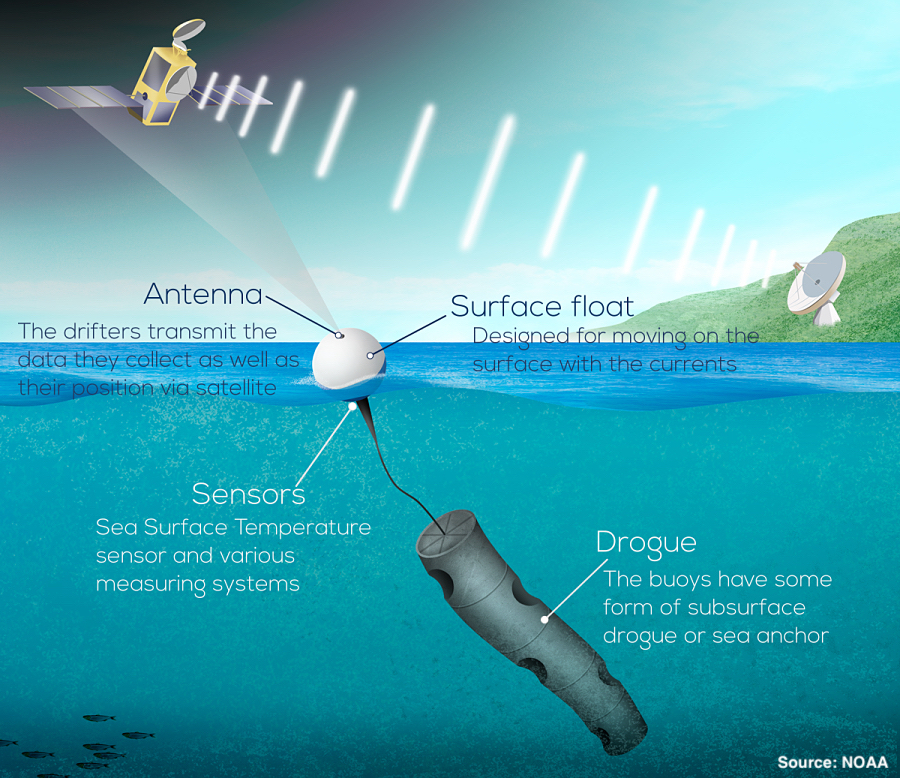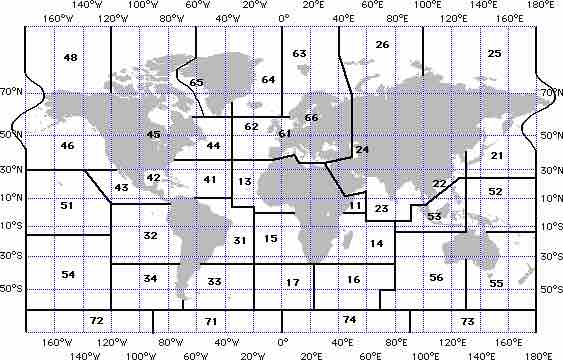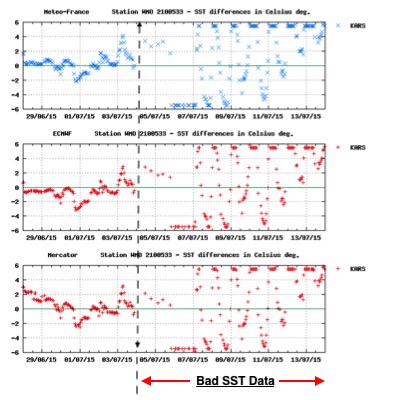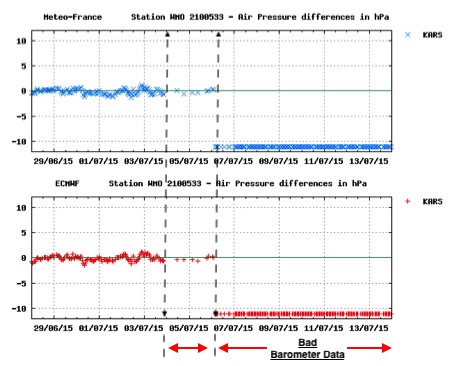Data Frequently Asked Questions (FAQs)
Background
Drifter ID vs. WMO Number
Data Access
- Where do I find drifter data and how much does it cost?
- Where do I find real-time drifter data?
- How do I search for drifter data at a specific time and/or location?
- How often is the quality-controlled drifter database updated?
- How do I download the entire quality-controlled drifter database?
- Where do I find metadata files, with details about the drifters?
- What is oldest drifter data available?
Detect Sensor Failure
Background
Who uses drifter data?
- Primarily oceanographers, meteorologists, and climatologists deploy and utilize drifter data. However, because drifter data can be used to track oil spills, marine debris, larval fish dispersion, etc. there is a growing list of deploying partners and data consumers.
- Oceanographic and climate researchers analyze the data to find aspects of the data that can be applied to other observations or explain phenomena.
- In an effort to better educate K-12 students about the importance of the ocean and how drifters provide invaluable data, the GDP works closely with NOAA’s Adopt a Drifter Program. Through the Adopt a Drifter Program, the GDP encourages young scientists how to access drifter data and its many applications.
What is a data fix?
While possible to increase/decrease the time interval between data transmissions, the standard transmission rate for drifting buoys is one transmission per hour, at the top of each hour. A fix is when a satellite receives a particular transmission and relays it to a land-based data center.
What is kriging?
Kriging is an optimum interpolation procedure which is commonly used for two and three-dimensional analyses. It is the method used at the drifter Data Assembly Center to interpolate (fill in the gaps in the data) and make them equally spaced into six hour intervals.
See Hansen, D.V. and Poulain, P.M., 1996, [PDF] for a complete description of the quality controlled and interpolation procedures applied to the drifter data in this database.
What is a Weighted Maximum Likelihood Estimate (WMLE)?
WMLE is an optimized model for the most likely location of a drifter given an estimate and a known error range. It is the method used at the drifter Data Assembly Center to interpolate (fill in the gaps in the data) and make them equally spaced into hourly intervals.
For more information, see Elipot et al. (2016) [PDF].
Drifter ID vs. WMO Number
What is the difference between drifter ID numbers and World Meteorological Organization (WMO) numbers?
Drifter ID numbers are preprogrammed into each transmitter. Thus, each drifter is identified by the transmitter inside, as the ID number is sent as a “signature” within each data message received. With nearly 1300 drifters transmitting every hour, it is essential to differentiate messages and separate them accordingly. The WMO number is assigned after the deployment region is identified. This number is the seven digit number used to reference data placed onto the Global Telecommunication System (GTS), for public distribution and archiving.
How and when are WMO numbers assigned?
WMO numbers are assigned after the deployment region is identified. WMO numbers are seven digit numbers used to reference data placed onto the Global Telecommunication System (GTS), for public distribution and archive. The first two digits of the WMO number correspond to the deployment region, which can be found on the map below.
Where do you find a WMO number for a particular drifter?
WMO numbers can be found in two places.
- If you already know the ID number of your particular drifter(s), please utilize the table found at:
aoml.noaa.gov/phod/dac/wmoid. - To find drifters within a specific region, or timeframe, please reference the GDP Directory File, at:
aoml.noaa.gov/phod/dac/dirall.
- The WMO number is shown in the second column, immediately to the right of the corresponding ID number. A sample of the Directory File can be found below.
Data Access
Where do I find drifter data and how much does it cost?
- Happily, the drifter data is FREE and accessible to the public, courtesy of NOAA's Climate Program Office!
- Drifter data are quality controlled and stored at AOML’s Drifter Data Assembly Center, then sent to Canada’s Marine Environmental Data Service for archiving and public distribution.
- For links and instructions to access real-time drifter data, please visit
aoml.noaa.gov/phod/gdp/real-time_data - For quality controlled interpolated drifter data, please visit
aoml.noaa.gov/phod/gdp/interpolated/data/all.
Where do I find real-time drifter data?
Links and instructions to access real-time drifter data, can be found at aoml.noaa.gov/phod/gdp/real-time_data.
How do I search for drifter data at a specific time and/or location?
- To search for real-time drifter data by specific time and location, visit
aoml.noaa.gov/phod/gdp/real-time_data. - To search for interpolated data by specific time, location and/or ID #, visit
aoml.noaa.gov/phod/gdp/interpolated/data/all. - To download the entire hourly drifter dataset, visit
aoml.noaa.gov/phod/gdp/hourly_data.
How often is the quality-controlled drifter database updated?
The quality controlled drifter data is updated every 2-3 months. Therefore quality controlled drifter data is available delayed mode, with notifications of these updates found at aoml.noaa.gov/phod/gdp.
How do I download the entire quality-controlled drifter database?
Quality controlled drifter data is available for download via the AOML GDP ERDDAP. For instuctions how to use ERDDAP to download subsets of GDP data in common file formats, visit 6-Hour Interpolated Data Request Instructions or Hourly Interpolated Data Request Instructions.
Quality controlled drifter data can aslo be downloaded from ftp://ftp.aoml.noaa.gov/pub/phod/buoydata, using a secure FTP client, such as FileZilla.
Where do I find metadata files, with details about the drifters?
Several files containing different kinds of metadata information are available on the web:
From the GDP Home page, select Global Drifter Program at the top of the screen, then navigate to Metadata. From there, you will find several options to choose from. Direct links are found below:
- Drifter Deployment Information:
aoml.noaa.gov/phod/dac/deployed - Quality Controlled Metadata:
aoml.noaa.gov/phod/dac/dirall - Drifter Death Probabilities:
aoml.noaa.gov/phod/dac/drifter_deaths
Hardware metadata are available at:
- Drifter Specifications:
aoml.noaa.gov/phod/dac/Drifter_Specifications - Barometer Specifications:
aoml.noaa.gov/phod/dac/Barometer_Metadata - Drogue Specifications:
aoml.noaa.gov/phod/dac/Drogue_Specifications
What is oldest drifter data available?
The Global Drifter Program was established in 1979. While it took several decades to develop the program and reach its current state, with roughly 31,200 transmissions per day, the first drifter to transmit data was deployed on February 14, 1979.
Detect Sensor Failure
How do I determine if a drifter has lost its drogue? Why is this important?
Determining drogue presence is vitally important, as this component of the drifter is what allows researchers to measure ocean current velocities at 15 meters depth. Without the drogue, which is centered at 15m, wind plays a greater roll in transporting drifters.
For this reason, AOML's Data Assembly Center spends a tremendous amount of time and resources to pinpoint exactly when, and where, each drifter loses its drogue.
While sensor failures are identified and listed within the quality controlled dataset, you can determine real-time sensor functionality by uilizing the WMO number from a particular drifter and visiting meteo.shom.fr/qctools.
An example of a drifter that has lost its drogue is shown in the figure below. Notice, the amount of strain on the lower hull of the surface float decreases significantly after drogue loss. At the same time, the time to first fix (how long it takes to acquire a GPS location fix) decreases significantly because the drogue is no longer pulling the surface float underwater with each passing wave.
How do I determine if the sea surface temperature sensor has failed?
All drifters are equipped with a sea surface temperature sensor at the base of the surface float.
While sensor failures are identified and listed within the quality controlled dataset, you can determine real-time sensor functionality by uilizing the WMO number from a particular drifter and visiting meteo.shom.fr/qctools.
An example of a failed sea surface temperature sensor is shown in the figure below. Notice, the structured diurnal pattern becomes erratic and irregular on Aug. 4th, 2015.
How do I determine if the barometric pressure sensor has failed?
While not all drifters are equipped with barometric pressure sensors, nearly half of the global drifter array measures sea-level pressure, which feeds into weather forecasting models.
While sensor failures are identified and listed within the quality controlled dataset, you can determine real-time sensor functionality by uilizing the WMO number from a particular drifter and visiting meteo.shom.fr/qctools.
An example of a failed pressure sensor is shown in the figure below. Notice, the slight pressure fluctuations begin on August 4th, 2015, then the sensor experiences complete failure on August 6th, 2015.
Contact Information
Whom to contact with more specific questions about drifter data?
- If you have specific questions about drifter data that you cannot find within the GDP website, or within these FAQs, please contact Shaun Dolk.
- To contact another member of the GDP, please visit Contacts.
- If you have general questions about drifters, please visit GDP FAQs or the GDP Home Page.





